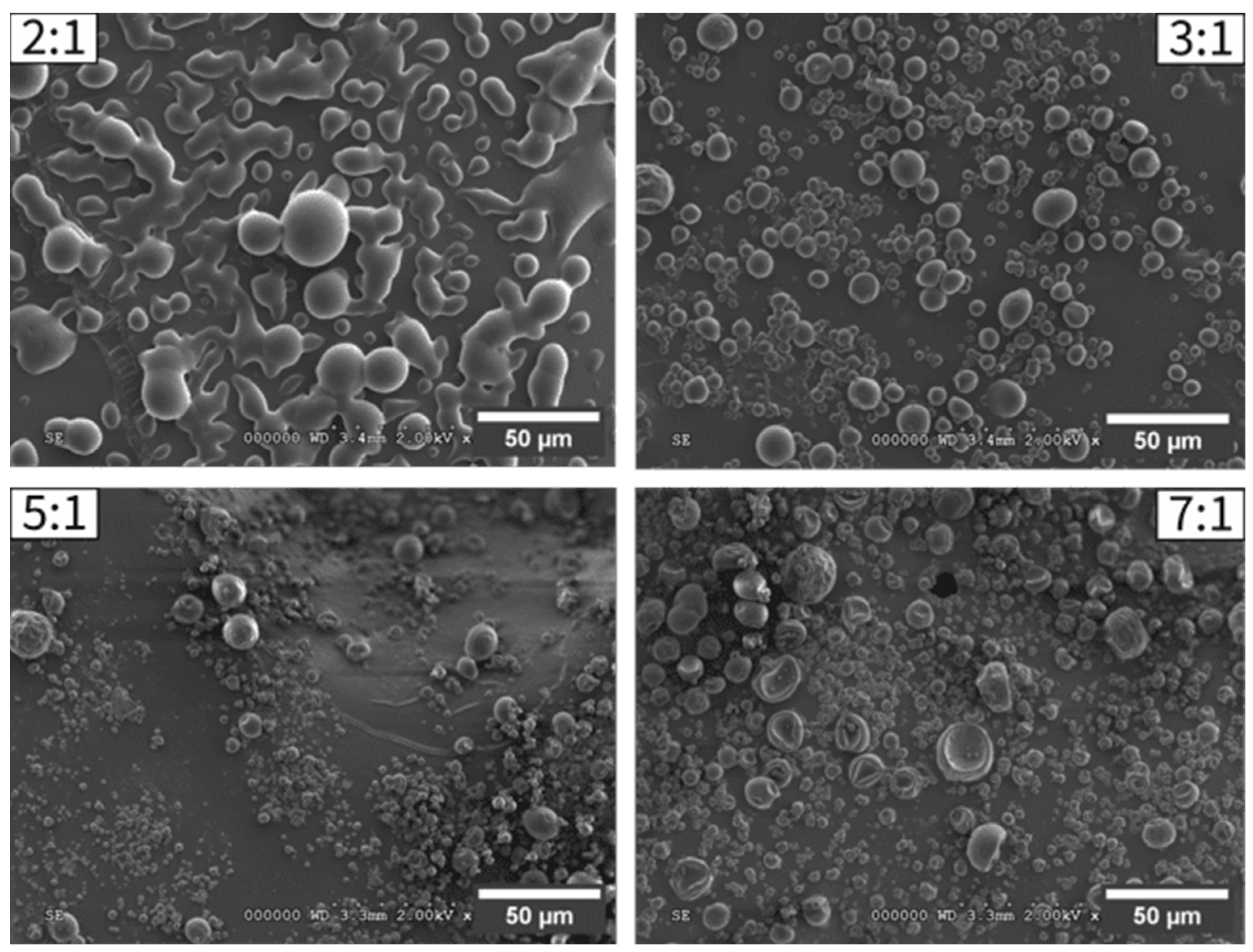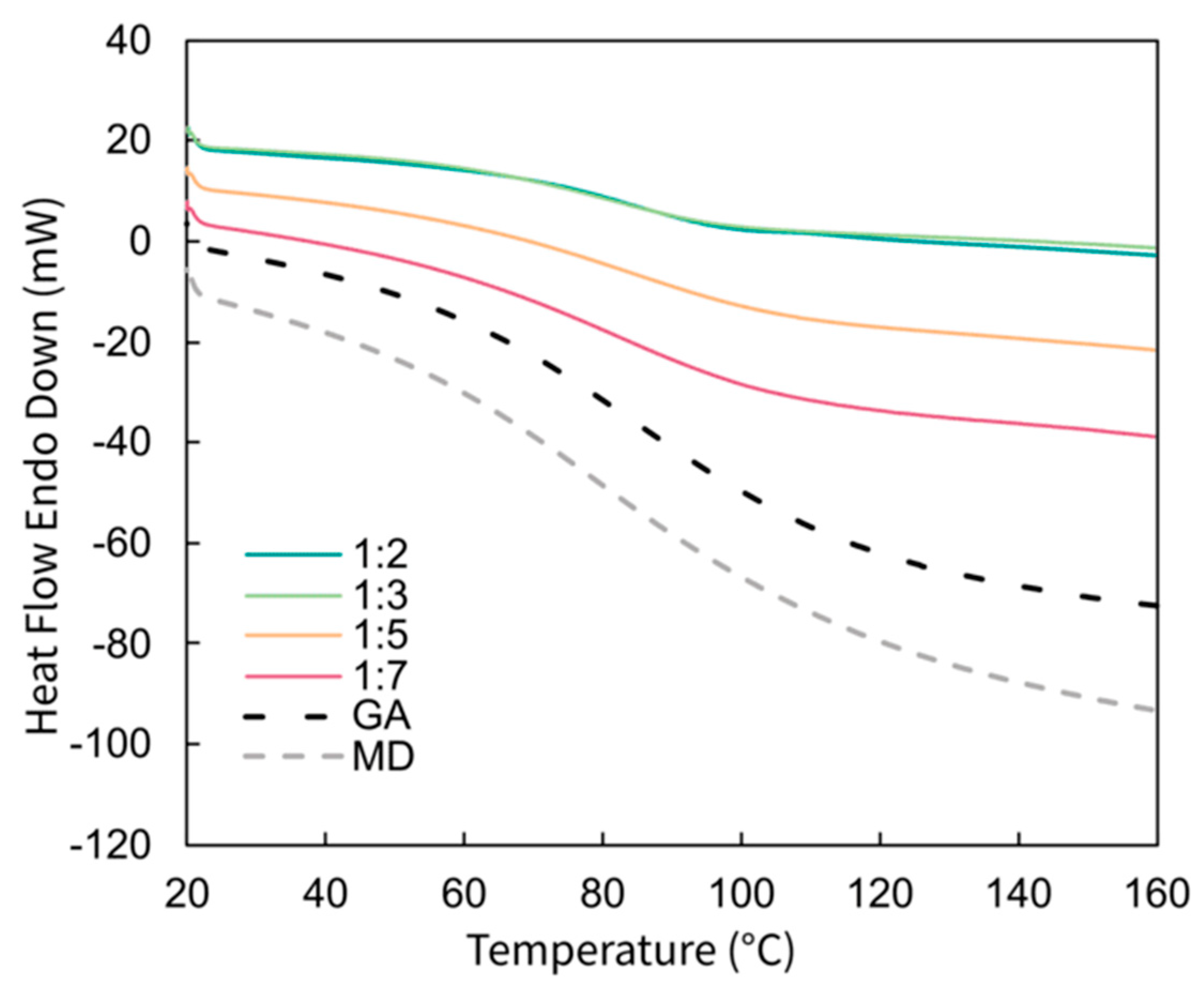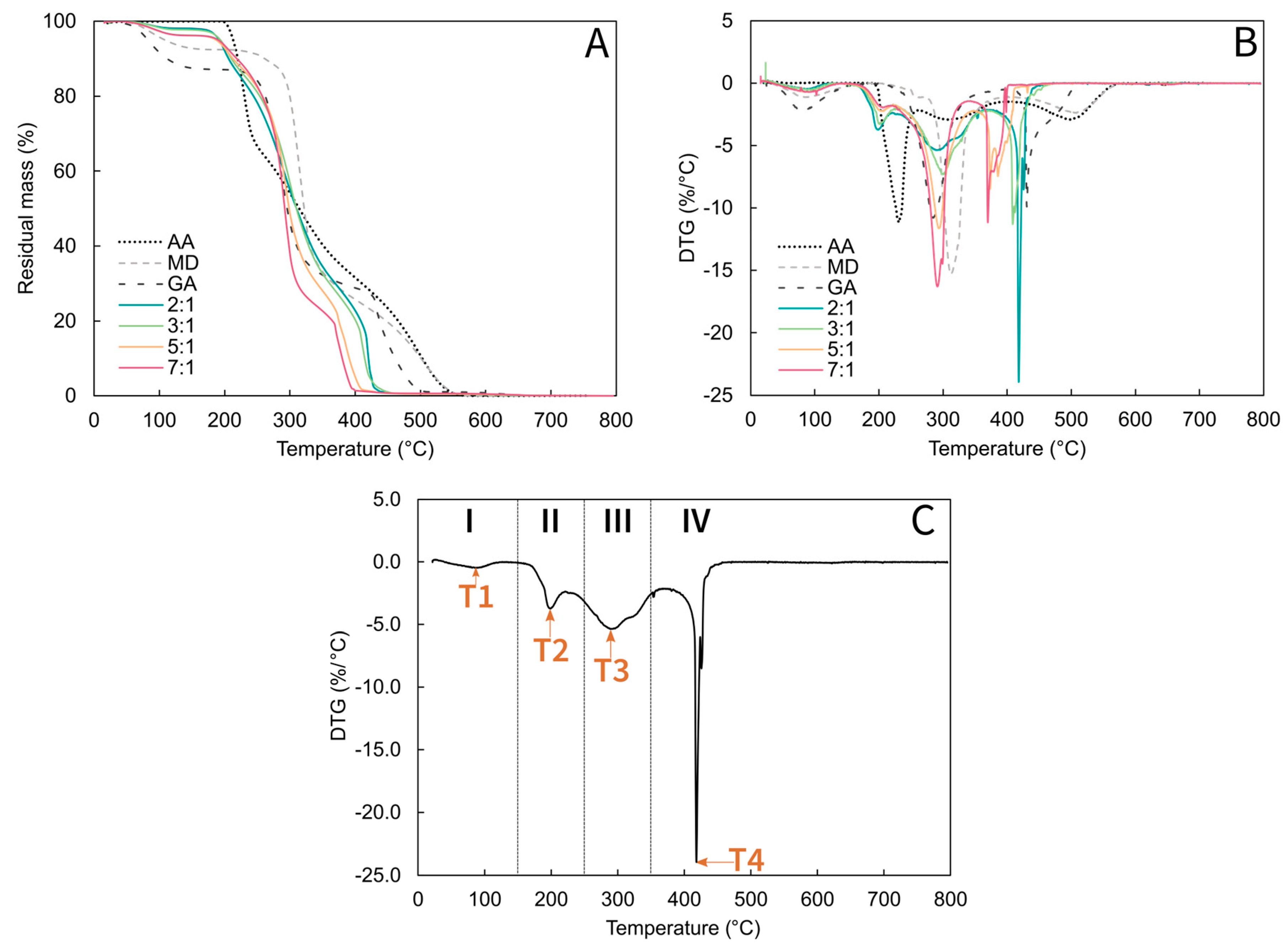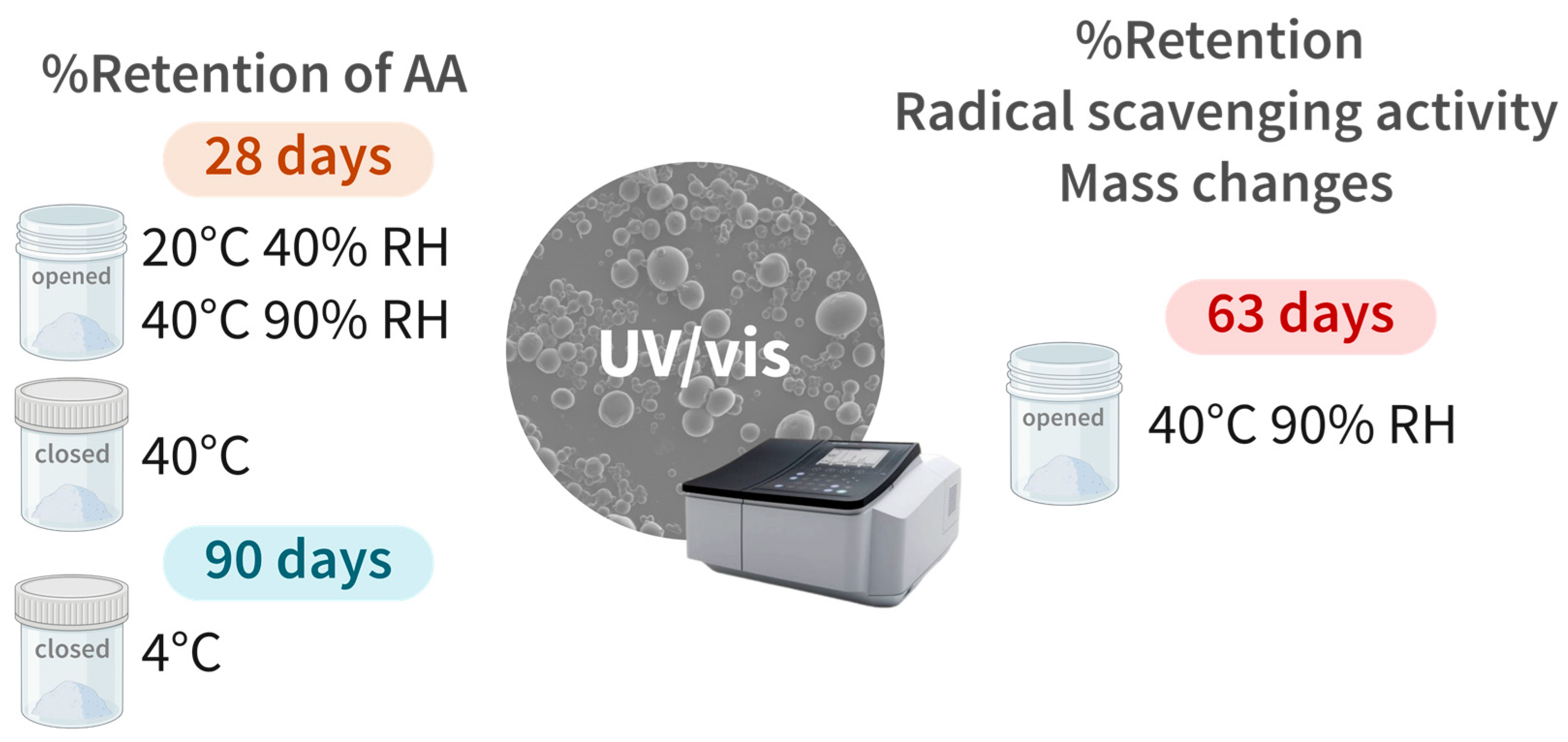Impact of Wall Material-to-Active Ratio in the Stability of Spray-Dried Ascorbic Acid Using Maltodextrin and Gum Arabic
Abstract
:1. Introduction
2. Results and Discussion
2.1. Microparticles Production and Characterization
2.1.1. Preparation of the Solutions
2.1.2. Active Loading and Encapsulation Efficiency
2.1.3. Antioxidant Activity of Encapsulated AA
2.2. Hygroscopicity
2.3. Morphology and Particle Size
2.4. Differential Scanning Calorimetry
2.5. Thermogravimetric Analysis (TGA)
2.6. Retention of Encapsulated AA under Various Storage Conditions (UV/vis)
2.7. Long-Term Stability—40 °C/90% RH
2.7.1. Effect of Storage on Microparticles and Pure AA
2.7.2. Retention of AA during Storage
2.7.3. Impact of Storage on Antioxidant Activity of Encapsulated AA
3. Materials and Methods
3.1. Material
3.2. Preparation of MDGA-AA Microparticles
3.2.1. Preparation of the Solutions
3.2.2. Experimental Conditions—Spray-Drying Process
3.3. Spray-Dried Powder Characterization
3.3.1. Active Loading and Encapsulation Efficiency
3.3.2. 2,2-Diphenyl-1-Picrylhydrazyl (DPPH) Radical Scavenging Activity
3.3.3. Hygroscopicity
3.3.4. Particle Morphology and Size Distribution
3.3.5. Differential Scanning Calorimetry
3.3.6. Thermal Gravimetric Analyses (TGA)/Derivative Thermogravimetric Analyses (DTG)
3.4. Storage Stability of Microparticles
3.4.1. Short-Term Stability
3.4.2. Long-Term Stability
3.5. Statistical Analyses
4. Conclusions
Supplementary Materials
Author Contributions
Funding
Institutional Review Board Statement
Informed Consent Statement
Data Availability Statement
Acknowledgments
Conflicts of Interest
References
- Sheraz, M.; Ahmed, S.; Shahnavi, I.; Vaid, F.; Iqbal, K. Formulation and Stability of Ascorbic Acid in Topical Preparations. Syst. Rev. Pharm. 2011, 2, 86–90. [Google Scholar] [CrossRef]
- Yin, X.; Chen, K.; Cheng, H.; Chen, X.; Feng, S.; Song, Y.; Liang, L. Chemical Stability of Ascorbic Acid Integrated into Commercial Products: A Review on Bioactivity and Delivery Technology. Antioxidants 2022, 11, 153. [Google Scholar] [CrossRef] [PubMed]
- Van Bree, I.; Baetens, J.M.; Samapundo, S.; Devlieghere, F.; Laleman, R.; Vandekinderen, I.; Noseda, B.; Xhaferi, R.; De Baets, B.; De Meulenaer, B. Modelling the Degradation Kinetics of Vitamin C in Fruit Juice in Relation to the Initial Headspace Oxygen Concentration. Food Chem. 2012, 134, 207–214. [Google Scholar] [CrossRef]
- Yuan, J.-P.; Chen, F. Degradation of Ascorbic Acid in Aqueous Solution. J. Agric. Food Chem. 1998, 46, 5078–5082. [Google Scholar] [CrossRef]
- Bakry, A.M.; Abbas, S.; Ali, B.; Majeed, H.; Abouelwafa, M.Y.; Mousa, A.; Liang, L. Microencapsulation of Oils: A Comprehensive Review of Benefits, Techniques, and Applications. Compr. Rev. Food Sci. Food Saf. 2016, 15, 143–182. [Google Scholar] [CrossRef] [PubMed]
- Gonçalves, A.; Estevinho, B.N.; Rocha, F. Microencapsulation of Vitamin A: A Review. Trends Food Sci. Technol. 2016, 51, 76–87. [Google Scholar] [CrossRef]
- Carvalho, I.T.; Estevinho, B.N.; Santos, L. Application of microencapsulated essential oils in cosmetic and personal healthcare products—A review. Int. J. Cosmet. Sci. 2016, 38, 109–119. [Google Scholar] [CrossRef] [PubMed]
- Chang, D.; Hayat, K.; Abbas, S.; Zhang, X. Ascorbic Acid Encapsulation in a Glassy Carbohydrate Matrix via Hot Melt Extrusion: Preparation and Characterization. Food Sci. Technol. 2019, 39, 660–666. [Google Scholar] [CrossRef]
- Nehru, S.; Guru, A.; Pachaiappan, R.; Hatamleh, A.A.; Al-Dosary, M.A.; Arokiyaraj, S.; Sundaramurthy, A.; Arockiaraj, J. Co-Encapsulation and Release of Apigenin and Ascorbic Acid in Polyelectrolyte Multilayer Capsules for Targeted Polycystic Ovary Syndrome. Int. J. Pharm. 2024, 651, 123749. [Google Scholar] [CrossRef]
- Vayachuta, L.; Leang, M.; Ruamcharoen, J.; Thiramanas, R.; Prateepchinda, S.; Prompinit, P.; Du-a-man, S.; Wisutthathum, S.; Waranuch, N. Printable-Microencapsulated Ascorbic Acid for Personalized Topical Delivery. ACS Appl. Bio Mater. 2023, 6, 5385–5398. [Google Scholar] [CrossRef]
- Janmohammadi, M.; Nourbakhsh, M.S.; Bonakdar, S. Electrospun Skin Tissue Engineering Scaffolds Based on Polycaprolactone/Hyaluronic Acid/L-Ascorbic Acid. Fibers Polym. 2021, 22, 19–29. [Google Scholar] [CrossRef]
- Carneiro, H.C.F.; Tonon, R.V.; Grosso, C.R.F.; Hubinger, M.D. Encapsulation Efficiency and Oxidative Stability of Flaxseed Oil Microencapsulated by Spray Drying Using Different Combinations of Wall Materials. J. Food Eng. 2013, 115, 443–451. [Google Scholar] [CrossRef]
- Soottitantawat, A.; Bigeard, F.; Yoshii, H.; Furuta, T.; Ohkawara, M.; Linko, P. Influence of Emulsion and Powder Size on the Stability of Encapsulated D-Limonene by Spray Drying. Innov. Food Sci. Emerg. Technol. 2005, 6, 107–114. [Google Scholar] [CrossRef]
- Estevinho, B.N.; Rocha, F.; Santos, L.; Alves, A. Microencapsulation with Chitosan by Spray Drying for Industry Applications—A Review. Trends Food Sci. Technol. 2013, 31, 138–155. [Google Scholar] [CrossRef]
- Jafari, S.M.; Assadpoor, E.; He, Y.; Bhandari, B. Encapsulation Efficiency of Food Flavours and Oils during Spray Drying. Dry. Technol. 2008, 26, 816–835. [Google Scholar] [CrossRef]
- Hoyos-Leyva, J.D.; Chavez-Salazar, A.; Castellanos-Galeano, F.; Bello-Perez, L.A.; Alvarez-Ramirez, J. Physical and Chemical Stability of L-Ascorbic Acid Microencapsulated into Taro Starch Spherical Aggregates by Spray Drying. Food Hydrocoll. 2018, 83, 143–152. [Google Scholar] [CrossRef]
- Palma-Rodríguez, H.M.; Alvarez-Ramírez, J.; Vargas-Torres, A. Using Modified Starch/Maltodextrin Microparticles for Enhancing the Shelf Life of Ascorbic Acid by the Spray-Drying Method. Starch Stärke 2018, 70, 1700323. [Google Scholar] [CrossRef]
- de Souza, C.A.G.; Siqueira, S.M.C.; de Amorim, A.F.V.; de Morais, S.M.; Gonçalves, T.; Gomes, R.N.; Cunha, A.P.; Ricardo, N.M.P.S. Encapsulation of L-ascorbic acid within the natural biopolymer-galactomannan-using the spray-drying method: Preparation, characterization, and evaluation of antioxidant activity. Quím. Nova 2015, 38, 877–883. [Google Scholar] [CrossRef]
- Marcela, F.; Lucía, C.; Esther, F.; Elena, M. Microencapsulation of L-Ascorbic Acid by Spray Drying Using Sodium Alginate as Wall Material. J. Encapsulation Adsorpt. Sci. 2016, 6, 64133. [Google Scholar] [CrossRef]
- Alvim, I.D.; Stein, M.A.; Koury, I.P.; Dantas, F.B.H.; Cruz, C.L. de C.V. Comparison between the Spray Drying and Spray Chilling Microparticles Contain Ascorbic Acid in a Baked Product Application. LWT Food Sci. Technol. 2016, 65, 689–694. [Google Scholar] [CrossRef]
- Finotelli, P.V.; Rocha-Leão, M.H.M. Microencapsulation of Ascorbic Acid in Maltodextrin and Capsul Using Spray-Drying. In Second Mercosur Congress on Chemical Engineering; ENPROMER: Costa Verde, Brazil, 2005. [Google Scholar]
- Barra, P.A.; Márquez, K.; Gil-Castell, O.; Mujica, J.; Ribes-Greus, A.; Faccini, M. Spray-Drying Performance and Thermal Stability of L-Ascorbic Acid Microencapsulated with Sodium Alginate and Gum Arabic. Molecules 2019, 24, 2872. [Google Scholar] [CrossRef]
- Mujica-Álvarez, J.; Gil-Castell, O.; Barra, P.A.; Ribes-Greus, A.; Bustos, R.; Faccini, M.; Matiacevich, S. Encapsulation of Vitamins A and E as Spray-Dried Additives for the Feed Industry. Molecules 2020, 25, 1357. [Google Scholar] [CrossRef]
- Ribeiro, A.M.; Shahgol, M.; Estevinho, B.N.; Rocha, F. Microencapsulation of Vitamin A by Spray-Drying, Using Binary and Ternary Blends of Gum Arabic, Starch and Maltodextrin. Food Hydrocoll. 2020, 108, 106029. [Google Scholar] [CrossRef]
- Ballesteros, L.F.; Ramirez, M.J.; Orrego, C.E.; Teixeira, J.A.; Mussatto, S.I. Encapsulation of Antioxidant Phenolic Compounds Extracted from Spent Coffee Grounds by Freeze-Drying and Spray-Drying Using Different Coating Materials. Food Chem. 2017, 237, 623–631. [Google Scholar] [CrossRef] [PubMed]
- Mahdavi, S.A.; Jafari, S.M.; Assadpoor, E.; Dehnad, D. Microencapsulation Optimization of Natural Anthocyanins with Maltodextrin, Gum Arabic and Gelatin. Int. J. Biol. Macromol. 2016, 85, 379–385. [Google Scholar] [CrossRef] [PubMed]
- Tolun, A.; Altintas, Z.; Artik, N. Microencapsulation of Grape Polyphenols Using Maltodextrin and Gum Arabic as Two Alternative Coating Materials: Development and Characterization. J. Biotechnol. 2016, 239, 23–33. [Google Scholar] [CrossRef]
- Karaaslan, M.; Şengün, F.; Cansu, Ü.; Başyiğit, B.; Sağlam, H.; Karaaslan, A. Gum Arabic/Maltodextrin Microencapsulation Confers Peroxidation Stability and Antimicrobial Ability to Pepper Seed Oil. Food Chem. 2021, 337, 127748. [Google Scholar] [CrossRef] [PubMed]
- Nizori, A.; Bui, L.T.T.; Jie, F.; Small, D.M. Spray-Drying Microencapsulation of Ascorbic Acid: Impact of Varying Loading Content on Physicochemical Properties of Microencapsulated Powders. J. Sci. Food Agric. 2020, 100, 4165–4171. [Google Scholar] [CrossRef] [PubMed]
- Tan, L.H.; Chan, L.W.; Heng, P.W.S. Effect of Oil Loading on Microspheres Produced by Spray Drying. J. Microencapsul. 2005, 22, 253–259. [Google Scholar] [CrossRef] [PubMed]
- Bhandari, B.R.; Dumoulin, E.D.; Richard, H.M.J.; Noleau, I.; Lebert, A.M. Flavor Encapsulation by Spray Drying: Application to Citral and Linalyl Acetate. J. Food Sci. 1992, 57, 217–221. [Google Scholar] [CrossRef]
- Tonon, R.V.; Grosso, C.R.F.; Hubinger, M.D. Influence of Emulsion Composition and Inlet Air Temperature on the Microencapsulation of Flaxseed Oil by Spray Drying. Food Res. Int. 2011, 44, 282–289. [Google Scholar] [CrossRef]
- de Barros Fernandes, R.V.; Marques, G.R.; Borges, S.V.; Botrel, D.A. Effect of Solids Content and Oil Load on the Microencapsulation Process of Rosemary Essential Oil. Ind. Crops Prod. 2014, 58, 173–181. [Google Scholar] [CrossRef]
- Silva, P.I.; Stringheta, P.C.; Teófilo, R.F.; de Oliveira, I.R.N. Parameter Optimization for Spray-Drying Microencapsulation of Jaboticaba (Myrciaria jaboticaba) Peel Extracts Using Simultaneous Analysis of Responses. J. Food Eng. 2013, 117, 538–544. [Google Scholar] [CrossRef]
- Frascareli, E.C.; Silva, V.M.; Tonon, R.V.; Hubinger, M.D. Effect of Process Conditions on the Microencapsulation of Coffee Oil by Spray Drying. Food Bioprod. Process. 2012, 90, 413–424. [Google Scholar] [CrossRef]
- Kurozawa, L.E.; Park, K.J.; Hubinger, M.D. Effect of Carrier Agents on the Physicochemical Properties of a Spray Dried Chicken Meat Protein Hydrolysate. J. Food Eng. 2009, 94, 326–333. [Google Scholar] [CrossRef]
- Oliveira, B.F.; Santana, M.H.A.; Ré, M.I. Spray-Dried Chitosan Microspheres Cross-Linked with d, l-Glyceraldehyde as a Potential Drug Delivery System: Preparation and Characterization. Braz. J. Chem. Eng. 2005, 22, 353–360. [Google Scholar] [CrossRef]
- Rodklongtan, A.; Nitisinprasert, S.; Chitprasert, P. Antioxidant Activity and the Survival-Enhancing Effect of Ascorbic Acid on Limosilactobacillus Reuteri KUB-AC5 Microencapsulated with Lactose by Spray Drying. LWT 2022, 164, 113645. [Google Scholar] [CrossRef]
- de Barros Fernandes, R.V.; Borges, S.V.; Botrel, D.A. Gum Arabic/Starch/Maltodextrin/Inulin as Wall Materials on the Microencapsulation of Rosemary Essential Oil. Carbohydr. Polym. 2014, 101, 524–532. [Google Scholar] [CrossRef] [PubMed]
- Iturri, M.S.; Calado, C.M.B.; Prentice, C. Microparticles of Eugenia Stipitata Pulp Obtained by Spray-Drying Guided by DSC: An Analysis of Bioactivity and in Vitro Gastrointestinal Digestion. Food Chem. 2021, 334, 127557. [Google Scholar] [CrossRef]
- Juhász, M.; Kitahara, Y.; Takahashi, S.; Fujii, T. Thermal Stability of Vitamin C: Thermogravimetric Analysis and Use of Total Ion Monitoring Chromatograms. J. Pharm. Biomed. Anal. 2012, 59, 190–193. [Google Scholar] [CrossRef]
- Pischetsrieder, M.; Larisch, B.; Severin, T. The Maillard Reaction of Ascorbic Acid with Amino Acids and Proteins—Identification of Products. In The Maillard Reaction in Foods and Medicine; Elsevier: Amsterdam, The Netherlands, 2005; pp. 107–112. ISBN 978-1-85573-791-4. [Google Scholar]
- Ferrari, C.C.; Marconi Germer, S.P.; Alvim, I.D.; De Aguirre, J.M. Storage Stability of Spray-Dried Blackberry Powder Produced with Maltodextrin or Gum Arabic. Dry. Technol. 2013, 31, 470–478. [Google Scholar] [CrossRef]
- Righetto, A.M.; Netto, F.M. Vitamin C Stability in Encapsulated Green West Indian Cherry Juice and in Encapsulated Synthetic Ascorbic Acid. J. Sci. Food Agric. 2006, 86, 1202–1208. [Google Scholar] [CrossRef]
- Wang, X.; Ma, N.; Lei, T.; Größ, J.; Li, G.; Liu, F.; Meusel, H.; Mikhailov, E.; Wiedensohler, A.; Su, H. Effective Density and Hygroscopicity of Protein Particles Generated with Spray-Drying Process. J. Aerosol Sci. 2019, 137, 105441. [Google Scholar] [CrossRef]
- Hu, Y.; Li, Y.; Zhang, W.; Kou, G.; Zhou, Z. Physical Stability and Antioxidant Activity of Citrus Flavonoids in Arabic Gum-Stabilized Microcapsules: Modulation of Whey Protein Concentrate. Food Hydrocoll. 2018, 77, 588–597. [Google Scholar] [CrossRef]
- Kumar, N.; Gusain, A.; Kumar, J.; Singh, R.; Hota, P.K. Anti-Oxidation Properties of 2-Substituted Furan Derivatives: A Mechanistic Study. J. Lumin. 2021, 230, 117725. [Google Scholar] [CrossRef]
- Tang, H.-J.; Zhang, X.-W.; Yang, L.; Li, W.; Li, J.-H.; Wang, J.-X.; Chen, J. Synthesis and Evaluation of Xanthine Oxidase Inhibitory and Antioxidant Activities of 2-Arylbenzo[ b ]Furan Derivatives Based on Salvianolic Acid C. Eur. J. Med. Chem. 2016, 124, 637–648. [Google Scholar] [CrossRef]
- Molaveisi, M.; Beigbabaei, A.; Akbari, E.; Noghabi, M.S.; Mohamadi, M. Kinetics of Temperature Effect on Antioxidant Activity, Phenolic Compounds and Color of Iranian Jujube Honey. Heliyon 2019, 5, e01129. [Google Scholar] [CrossRef] [PubMed]
- Brand-Williams, W.; Cuvelier, M.E.; Berset, C. Use of a Free Radical Method to Evaluate Antioxidant Activity. LWT Food Sci. Technol. 1995, 28, 25–30. [Google Scholar] [CrossRef]
- Cai, Y.Z.; Corke, H. Production and Properties of Spray-Dried Amaranthus Betacyanin Pigments. J. Food Sci. 2000, 65, 1248–1252. [Google Scholar] [CrossRef]
Disclaimer/Publisher’s Note: The statements, opinions, and data contained in all publications are solely those of the individual author(s) and contributor(s) and not of MDPI and/or the editor(s). MDPI and/or the editor(s) disclaim responsibility for any injury to people or property resulting from any ideas, methods, instructions, or products referred to in the content. |







| Ratio WM:A (w/w) | Yield (%) | Active Loading (%) | Encapsulation Efficiency (%) | Radical Scavenging Activity | Initial Moisture Content (%) | %Hygroscopicity | Tg (°C) |
|---|---|---|---|---|---|---|---|
| (%Scavenging Activity/mg of Powder) | |||||||
| 2:1 | 48.0 ± 0.7 ab | 40.6 ± 1.6 a | 58.5 ± 1.6 a | 4.1 ± 0.2 a | 1.9 ± 0.0 a | 12.7 ± 0.2 a | 81.1 ± 3.2 a |
| 3:1 | 46.3 ± 0.9 b | 29.8 ± 1.4 b | 55.1 ± 2.2 a | 2.8 ± 0.1 b | 2.4 ± 0.1 b | 15.4 ± 0.4 b | 77.6 ± 1.4 a |
| 5:1 | 50.2 ± 5.7 ab | 20.1 ± 1.1 c | 64.1 ± 7.0 a | 2.0 ± 0.1 c | 3.6 ± 0.1 c | 18.4 ± 0.0 c | 79.6 ± 0.2 a |
| 7:1 | 55.6 ± 3.1 a | 15.3 ± 0.3 d | 68.2 ± 4.8 b | 1.4 ± 0.0 d | 3.9 ± 0.1 c | 19.3 ± 0.0 c | 80.7 ± 0.9 a |
| Sample | Degradation Step (°C) | Mass Loss (%) | ||||||
|---|---|---|---|---|---|---|---|---|
| T1 | T2 | T3 | T4 | I | II | III | IV | |
| 2-1 | 88.7 | 198.8 | 292.6 | 418 | 1.9 | 19.8 | 43.7 | 34.6 |
| 3-1 | 87.9 | 199.6 | 301 | 408.6 | 2.3 | 16.7 | 48.4 | 32.7 |
| 5-1 | 83.3 | 204.6 | 293.1 | 373.5 | 3.8 | 13.9 | 54.2 | 28.1 |
| 7-1 | 91.1 | 205.7 | 291.2 | 369.8 | 3.8 | 13.6 | 60 | 22.7 |
| MDGA | 92.39 | - | 290.1 | 370.4 | 5.4 | 13.8 | 60.5 | 20.3 |
| AA | - | 230.8 | 312.2 | 498.5 | 0 | 33.3 | 26.3 | 40.4 |
| MD | 86.7 | - | 312.3 | 508.1 | 7.2 | 1.6 | 58 | 33.2 |
| GA | 79.4 | - | 284 | 430.5 | 12.5 | 3.3 | 51.9 | 32.3 |
Disclaimer/Publisher’s Note: The statements, opinions and data contained in all publications are solely those of the individual author(s) and contributor(s) and not of MDPI and/or the editor(s). MDPI and/or the editor(s) disclaim responsibility for any injury to people or property resulting from any ideas, methods, instructions or products referred to in the content. |
© 2024 by the authors. Licensee MDPI, Basel, Switzerland. This article is an open access article distributed under the terms and conditions of the Creative Commons Attribution (CC BY) license (https://creativecommons.org/licenses/by/4.0/).
Share and Cite
Delaporte, A.; Duchemin, B.; Grisel, M.; Gore, E. Impact of Wall Material-to-Active Ratio in the Stability of Spray-Dried Ascorbic Acid Using Maltodextrin and Gum Arabic. Molecules 2024, 29, 3587. https://doi.org/10.3390/molecules29153587
Delaporte A, Duchemin B, Grisel M, Gore E. Impact of Wall Material-to-Active Ratio in the Stability of Spray-Dried Ascorbic Acid Using Maltodextrin and Gum Arabic. Molecules. 2024; 29(15):3587. https://doi.org/10.3390/molecules29153587
Chicago/Turabian StyleDelaporte, Adeline, Benoît Duchemin, Michel Grisel, and Ecaterina Gore. 2024. "Impact of Wall Material-to-Active Ratio in the Stability of Spray-Dried Ascorbic Acid Using Maltodextrin and Gum Arabic" Molecules 29, no. 15: 3587. https://doi.org/10.3390/molecules29153587






